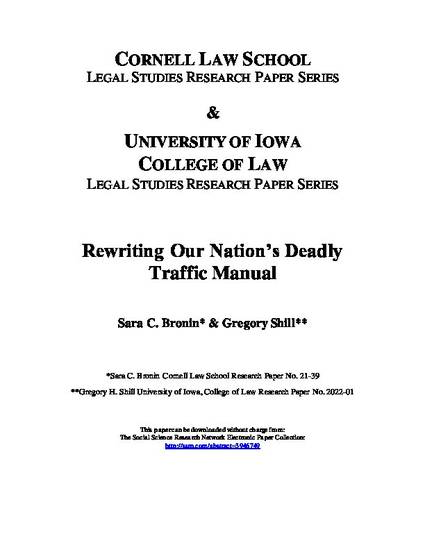
Article
Rewriting Our Nation's Final.pdf
Harvard Law Review Forum
(2021)
Abstract
Every day, Americans entrust their lives to a road system that is governed by the Manual on Uniform Traffic Control Devices for Streets and Highways (theManual). On its face, this Federal Highway Administration (FHWA) publication is a straightforward technical document. It contains over eight hundred pages ofengineering guidance on everything from traffic-light placement to the font of highway signs. It also establishes acceptable methods for officials to modify speedlimits.
While such provisions may sound inconsequential, some of the Manual’s provisions have far-reaching, even deadly, consequences. They prioritize vehicular speedover public safety, mobility over other uses of public space, and driving over other modes of mobility. With these car-centric priorities, the Manual has helpedgenerate a nearly constant and fast-moving stream of vehicle traffic that renders road users like pedestrians, wheelchair users, and cyclists vulnerable. Moreover, bygiving preference to driving over other modes of transportation, the Manual has indirectly facilitated a rise in transportation-related greenhouse gas emissions thatare the single largest contributor to climate change.
Despite the evidence stacked against some of its most important provisions, the Manual has stubbornly endured — perhaps because it has been virtually unknownoutside of transportation engineering and urban planning. But over the past year, the Manual has finally started to receive the scrutiny it deserves. In 2020, the FHWA proposed a new draft of the Manual that would maintain the current version’s most outdated and discredited features. During a recently closed notice-and-comment process, the agency received over 26,500 comments. Even in the unlikely event that the agency rips up the proposed revisions and starts fresh, the core of the Manual will probably remain intact for years to come.
This Essay explains how the Manual biases transportation behavior in dangerous and inequitable ways. It urges the FHWA touse its emergency powers to rescind its most damaging provision — the so-called 85th Percentile Rule, which legalizesdangerously high speeds of traffic — and to undertake a complete rewrite that follows a scientifically sound, evidence-basedapproach; prioritizes safety, access, equity, climate action, and prosperity; and incorporates feedback from diverse stakeholders.
Keywords
- transportation,
- transportation law,
- urban planning,
- road design,
- land use,
- administrative law
Disciplines
Publication Date
2021
Citation Information
Sara Bronin. "Rewriting Our Nation's Final.pdf" Harvard Law Review Forum Vol. 135 Iss. 1 (2021) Available at: http://works.bepress.com/bronin/54/
